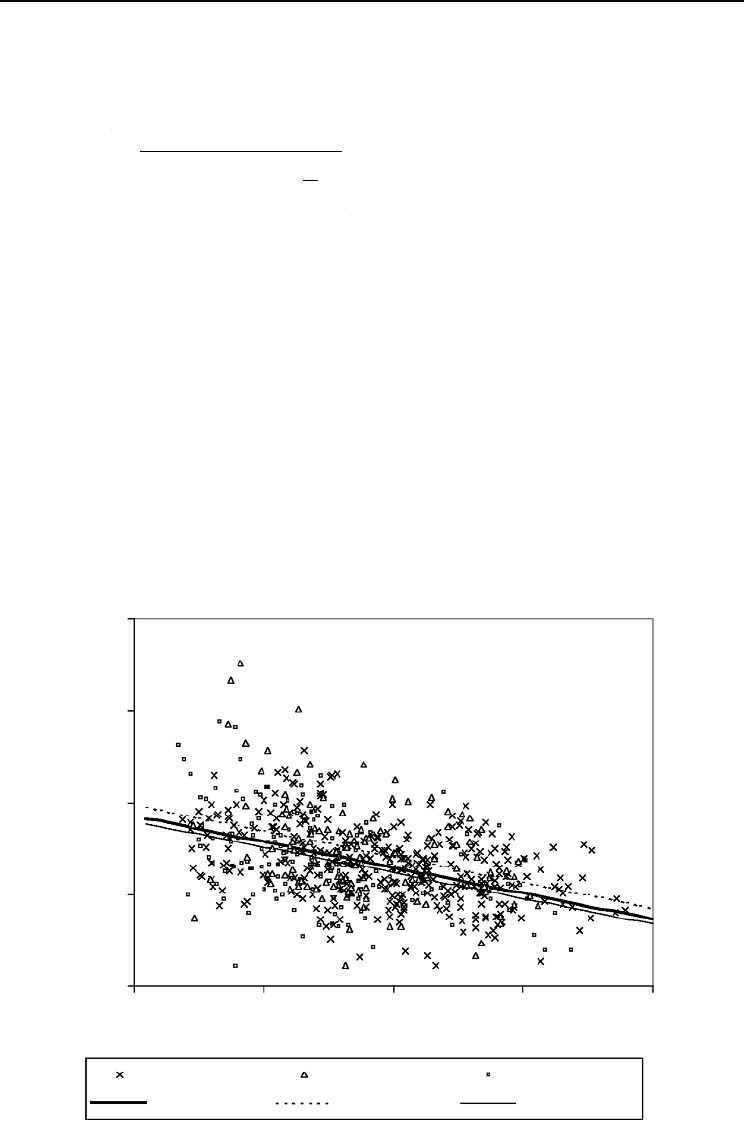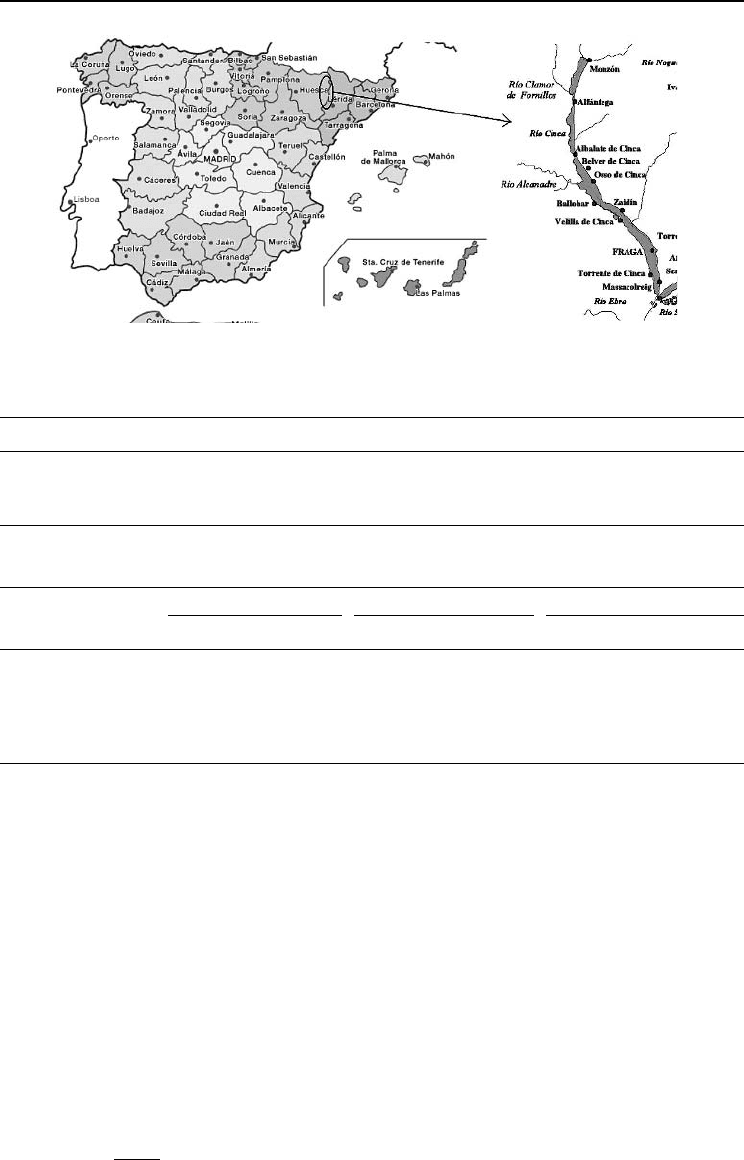Amaro A., Reed D., Soares P. (editors) Modelling Forest Systems
Подождите немного. Документ загружается.


17Amaro Forests - Chap 15 25/7/03 1:54 pm Page 176
176 A. Kiviste et al.
The coefficient of determination R
2
= 0.66 and the RMSE = 0.71 cm.
Using the moments method (Scolforo and Thierschi, 1998), the parameters of
Johnson’s S
B distribution can be predicted as follows:
ε
= 0.7 MIN
λ = MAX
µ
⋅−
µ
)
s
1
(
1
δ
= +⋅
− 8
(
1
s 4
µ
⋅−
µ
)
−
−1
γδ
=⋅
ln
0 5
µ
µ
+
µ
δ
.
where
ε
d −
µ
=
λ
STD
s =
MAX
¯
d = arithmetic mean diameter
Height–diameter relationships
To date, a total of 28,441 sample trees with height–diameter measurements have
been r
ecorded in the database of the Estonian permanent plot network. Records
were classified into groups by storeys and species, and only the groups containing
at least 25 trees were used for the modelling of height–diameter relationships. As a
result, a total of 14,821 height–diameter measurements from 292 stands were used in
the analysis of height–diameter models.
On the basis of sample tree data, parameters H and b of the Nilsons’
height–diameter equation wer
e calculated for each stand using the system of linear
equations. The residual standard error of the model was 1.36 m.
The scale parameter H of the model expr
esses the mean height of the stand cor-
responding to the quadratic mean diameter. The shape parameter b characterizes the
curvature of the height–diameter relationship (Fig. 15.4). Analysis of the estimates of
Relative height h/H
1.6
1.4
1.2
1.0
0.8
0.6
0.4
0.2
0.0
0.0 0.2 0.4 0.6 0.8 1.0 1.2 1.4 1.6 1.8 2.0
Relative diameter d/
D
b = 0.05 b = 0.1 b = 0.2 b = 0.4
Fig. 15.4. Standardized height–diameter curves by Nilson’s (1999) model for different values of shape
parameter b.

17Amaro Forests - Chap 15 25/7/03 1:54 pm Page 177
177 Diameter Distribution Models
the shape parameter b
to the quadratic mean diameter D
parameter b b = a D, we get a one-parameter
height–diameter model:
h d a is a con-
c is a constant
H is the mean height
Discussion and Conclusions
h
H
a D
D
d
c
=
−− ⋅
( )
⋅−
1 1.
0.8
0.6
0.4
0.2
0
Parameter b
0
Birch
0.359–0.0056D
Spruce
0.394–0.0056D
Pine
0.369–0.0056D
Quadratic mean diameter D (cm)
using Estonian growth plot data revealed a linear relationship
and the tree species (Fig. 15.5). By replacing the
with the linear relationship – 0.0056·
where is the tree height (m), is the tree breast height diameter (cm),
stant (0.369 for pine, 0.394 for spruce and 0.359 for other species),
(1.31 for pine, 1.47 for spruce and 1.38 for other species), and
parameter (corresponding to the quadratic mean diameter).
The residual standard error of the model was 1.50 m.
The creation of a network of permanent forest growth plots has been started in
Estonia. The network is designed for long-term observations of trees to be used for
building forest growth models for Estonia.
Numbering of trees with metallic tags or colour is a common practice in forest
permanent sample plots. We preferred the measurement of tree coordinates instead.
Re-measuring of almost 200 plots convinced us that the precision of the measure-
ments of azimuth and distance from plot centre was sufficient to ensure quick loca-
tion of the same trees 5 years later. The additional advantage of measuring of tree
0 0056
10 20 30 40
Fig. 15.5. Relationship between parameter b and quadratic mean diameter D on the basis of first-storey tree
data.

17Amaro Forests - Chap 15 25/7/03 1:54 pm Page 178
178 A. Kiviste et al.
coordinates is the availability of data for the construction of distance-dependent tree
growth models.
The establishment and maintenance of the network is an ongoing process.
Nevertheless, a considerable amount of data that can be used for modelling the for-
est str
ucture has already been collected.
The Johnson’s SB distribution was flexible enough to describe diameter distribu-
tions of Estonian for
ests. Regression methods of parameter estimation represented a
better fit than percentile methods. A diameter distribution model, the parameters of
which were predicted by stand variables, has been developed for Estonian forests.
Using the diameter distribution model, the parameters of which were predicted
by stand variables, 9% of the plots did not pass the Kolmogor
ov–Smirnov goodness-
of-fit test. When distribution parameters were estimated using empirical diameter
distribution (using the moments method), then all the plots passed the
Kolmogorov–Smirnov goodness-of-fit test. Thus, we did not manage to predict the
distribution parameters perfectly. It is likely that regular correlations between distri-
bution parameters and stand variables can be found in unmanaged forests; how-
ever, since thinning of stands is common practice in Estonia, it is unlikely that
perfect predictions of diameter distributions can be made.
A standardized height–diameter equation has been created for Estonian forests.
Depending on the number of height–diameter measur
ements, the equation can be
used as a one-parameter or two-parameter model. Model parameters can be esti-
mated by solving a system of linear equations.
For the height–diameter models, the values of parameter c wer
e estimated
according to main species. For this a data set was generated using Kuliesˇis’ (1993)
model for Lithuanian forests.
Residuals of the models were studied, and no significant effect of tree diameter,
quadratic mean diameter or tr
ee species was found either for the two-parameter or for
the one-parameter model. However, a dependency of residuals on relative diameter
d/D was found in the Estonian forest plot data. Therefore, further correction of the
parameter c estimates is needed. Also, we cannot rule out additional dependence of the
values of parameters b and c on stand age, stocking grade, management history and
other stand variables.
Acknowledgement
This study was supported by the Estonian Science Foundation, Grant No. 4813.
References
Bowman, K.O. and Shenton, L.R. (1983) Johnson’s system of distributions. In: Encyclopedia of
Statistical Sciences, Vol. 4. John Wiley & Sons, New York, pp. 303–314.
Curtis, R.O. (1983) Procedures for Establishing and Maintaining Permanent Plots for Silvicultural
and Yield Research. USDA General Technical Report PNW-155, 56 pp.
Gustavsen, H.G., Roiko-Jokela, P. and Varmola, M. (1988) Kivennäismaiden talousmetsien pysyvat
(INKA ja TINKA) kokeet. Suunnitelmat, mittausmenetelmät ja aineistojen rakenteet.
Metsäntutkimuslaitoksen tiedonantoja 292, 212 pp. [in Finnish].
Hägglund, B. (1981) Forecasting Growth and Yield in Established Forests: an Outline and Analysis of
Outcome of a Subprogram Within Hugin Project. Swedish Univerity of Agricultural Sciences,
Department of Forest Survey, Report 31, 145 pp.
Hökka, H. (1997) Models for Predicting Growth and Yield in Drained Peatland Stands in Finland.
Finnish Forest Research Institute, Research Paper 651, 45 pp.

17Amaro Forests - Chap 15 25/7/03 1:54 pm Page 179
179 Diameter Distribution Models
Huang, S., Price, D. and Titus, S.J. (2000) Development of ecoregion-based height–diameter
models for white spr
uce in boreal forests. Forest Ecology and Management 129, 125–141.
Hynynen, J., Ojansuu, R., Hökka, H., Siipilehto, J., Salminen, H. and Haapala, P. (2002) Models
for Predicting Stand Development in MELA System. Finnish Forest Research Institute,
Research Paper 835, 116 pp.
Johnson, N.L. (1949) Systems of frequency curves generated by methods of translation.
Biometrika 36, 149–176.
Kamziah, A.K., Ahmad, M.I. and Lapongan, J. (1999) Nonlinear regression approach to esti-
mating Johnson SB parameters for diameter data. Canadian Journal of Forest Research 29,
310–314.
Knoebel, B.R. and Burkhart, H.E. (1991) A bivariate approach to modelling forest diameter dis-
tributions at two points in time. Biometrics 47, 241–253.
Kuliesˇis, A. (1993) Lietuvos medynu prieaugio ir jo panaudojimo normatyvai. Kaunas, 383 pp. [in
Lithuanian].
Mängel, M. (2000) Puu ko˜rguse ja diameetri vahelise seose modelleerimine proovitükkide andmeil.
EPMÜ metsakorralduse instituut. Lo˜putöö, 40 pp. [in Estonian].
Nilson, A. (1999) Pidev metsakorraldus – mis see on. In: Pidev Metsakorraldus. EPMÜ
Metsandusteaduskonna toimetised 32, 4–13 [in Estonian].
SAS Institute (1989) SAS/STAT User’s Guide, Version 6, 4th edn, Vol. 2, SAS Institute, Cary,
North Carolina, 846 pp.
Scolforo, J.R.S. and Thierschi, A. (1998) Estimativas e testes da distribuição de frequência
diâmétrica para Eucalyptus camaldulensis, através da distribuição Sb, por diferentes méto-
dos de ajuste. Scientia Forestalis 54, 93–106.
Slifker, J.F. and Shapiro, S.S. (1980) The Johnson System: selection and parameter estimation.
Technometrics 22, 239–246.
Estonian Forest Survey (1999) Centre Instruction of National Forest Inventory Fieldworks. 55 pp.
Tarve, T. (1986) Puude rinnasdiameetri jaotus Rakvere metsamajandi puistutes. EPA metsakorral-
duse kateeder, 36 pp. [in Estonian].
Zar, J.H. (1999) Biostatistical Analysis. Prentice-Hall, Upper Saddle River, New Jersey, 663 pp.
Zhou, B. and McTague, J.P. (1996) Comparsion and evaluation of five methods of the Johnson
System parameters. Canadian Journal of Forest Research 26, 928–935.
17Amaro Forests - Chap 15 25/7/03 1:54 pm Page 180

18Amaro Forests - Chap 16 1/8/03 11:53 am Page 181
16 Modelling the Diameter at Breast
Height Growth of Populus
euramericana Plantations in Spain
Francisco Rodríguez,
1
José Antonio De la Rosa
1
and
Álvaro Aunós
1
Abstract
Preliminary results are presented in order to model the diameter at breast height growth of
three clones of Populus × euramericana (I-214, Luisa Avanzo and MC) in the Cinca valley
(Huesca, Spain) using data from re-measured permanent and measured temporary plots. The
model employed was an integral form of the Chapman–Richards equation with a reference age
established at 7 years. We built an anamorphic system of curves with different productivity
indexes (PIs), elaborating an empirical height–diameter relationship to estimate average height
based on a multiplicative model adapted by Cunia (1979).
Introduction
The hybrid poplar (Populus × euramericana) is a tree species of great economic impor-
tance in Spain, forming the basis of the peeler wood industry. According to the
Spanish Agriculture Department (Padró, 1992), poplar plantations occupy about
100,000 ha of forested area in Spain. Recently, these plantations have undergone a
remarkable expansion in areas such as the Cinca valley (Huesca province, northern
Spain), in which the hybrid clones I-214, Luisa Avanzo and MC are extensively
planted. This increase in forest land can be explained by two factors: (i) its rapid
growth and, (ii) its suitability for vegetative reproduction (Rueda et al., 1997).
Nowadays, poplars can be used as an alternative to less profitable agricultural
crops, partly due to the new orientations of the EU agrarian policies favouring the
reforestation of former agricultural land. However, despite the many hectares cur-
rently dedicated to poplars, more than 750,000 m
3
of wood is imported annually to
Spain.
One of the major concerns of forest managers in poplar plantations is related to
the possibility of pr
edicting the production of peeler wood in the future. This is also
critical in evaluating the sustainability of forest management practices within the
framework of the national forest policies. In this context, development of growth
models for the species represents a useful tool.
1
University of Lleida, UdL-ETSEA, Spain
Correspondence to: Francisco.Rodriguez@pvcf.udl.es
© CAB International 2003. Modelling Forest Systems (eds A. Amaro, D. Reed and P. Soares) 181

18Amaro Forests - Chap 16 1/8/03 11:53 am Page 182
182 F. Rodríguez et al.
Growth models are often a prerequisite for the prediction of stand-level volume
growth, where height of dominant and codominant trees in even-aged stands is
commonly used as a measure of forest productivity (Monserud, 1984). Traditionally,
these models, whether empirical or mechanistic, have been obtained by fitting
observed data to mathematical functions. Indeed, tree growth models usually
employ a set of equations to describe stand development over time.
The concept of a productivity curve, as defined for poplar plantations (Padró,
1982), describes the r
elationship between the age of the stand and its mean diameter
at breast height (DBH). In fact, the productivity index (i.e. DBH at a reference age,
PI) is seldom determined through direct observations but estimated by productivity
curves using the mean DBH and age of trees in the target stand. Such an estimation
assumes that the DBH growth pattern is associated with PI for a given tree species.
However, DBH–age curves for a given PI can differ significantly before and after the
reference age due to factors such as climate and site characteristics (Wang and
Huang, 2000).
For poplar plantations, a parallel is observed between productivity curves and
quality curves (i.e. the r
elationship between age of the stand and its dominant
height). This is because thinning is not performed in the area and pruning practices
have little influence on the diameter growth (Rodríguez et al., 2001). Under these cir-
cumstances, DBH is a good indicator of yield. The application of productivity
curves to any given poplar plantation allows for an assignment of a productivity
class to the stand and, knowing its mean DBH to any age, it also describes stand
development with time and allows a choice of rotation period based on the stand PI.
The objectives of this study were: (i) to develop a stand-level DBH growth
model specific for each clone (I-214, Luisa
Avanzo and MC) applicable throughout
the Cinca valley, and (ii) to classify the existing stands in the region by productivity
index.
Materials and Methods
Site description
The area of study is located in the Cinca valley (Huesca, Spain), with coordinates 0°
11 to 0° 08
, 41° 55 to 41° 31N (Fig. 16.1), with an average altitude of 188 m above
sea level. Poplar plantations are located in alluvial soils formed principally by grav-
els. The groundwater table is about 2 m deep.
The forest management is characterized by the following steps: (i) 1-year-old
poplars ar
e established on flood irrigation lands following square planting (6 × 6m,
with a total of 278 trees/ha); (ii) tillage is performed yearly to eliminate competition
by weeds; and (iii) the time period between irrigations is 15 days during summer at
a rate of approximately 2000 m
3
/ha (approximately 15,000 m
3
/hayear) (Padró,
1992).
The available data were collected throughout the inventoried areas of the Cinca
valley to pr
ovide representative information for a variety of site conditions. For each
felled tree, the following variables were measured: diameter at breast height (DBH),
total height and stand age (all the inventoried areas have the same density; 278
trees/ha). Data originated from re-measured permanent plots (544 DBH × age com-
binations) and temporary plots (295 DBH × age combinations). Table 16.1 classifies
the number of plots by type (permanent or temporary) for each clone, and Table 16.2
summarizes the data collected at the plot level. The number of measured trees by
plot was four in the temporary plots and nine in the permanent plots. I-214, the least

18Amaro Forests - Chap 16 1/8/03 11:53 am Page 183
183 Modelling Diameter at Breast Height Growth
Fig. 16.1. Area of the study.
Table 16.1. Summary of number of plots by type for each clone.
I-214 MC LA Count
Temporary 38 20.9% 141 40.5% 116 37.5% 295 35.16%
Permanent 144 79.1% 207 59.5% 193 62.5% 544 64.84%
Count 182 348 309 839
Table 16.2. Summary of data collected at the plot level
I-214 MC LA
Age (years) DBH (cm) Age (years) DBH (cm) Age (years) DBH (cm)
Count 182 347 309
Average 5.357 14.748 6.541 18.043 5.543 15.914
SD 4.094 12.415 3.919 10.715 2.804 9.0735
Minimum 1.0 2.3 1.0 2.425 1.0 1.075
Maximum 16.0 47.5 16.0 42.35 12.0 39.15
abundant clone in the area, was present in only 182 plots (i.e. about half of the plots
in which the other clones were represented).
Model fitting
The model proposed by Richards (1959) has been widely used in forestry. Its success
can be explained by the inclusion, in its dif
ferent forms, of the basic components of
growth (Equation 1) (Bravo, 1988). Biologically based models, such as the one by
Richards, have the advantage that the extrapolation of results out of the range of the
original data is safer than that for empirical models (Vanclay, 1994). Different forms
of Richards’ model are derived for use in growth modelling; Equation 2 is an inte-
gral form, whereas Equations 2a, 2b and 2c are different forms of the model.
α β
δ
DBH
=⋅DBH
n
−⋅ DBH
m
(1)
δ
t

18Amaro Forests - Chap 16 1/8/03 11:53 am Page 184
184 F. Rodríguez et al.
c
DBH =⋅ − exp
(
−b t
)
)
(2)
a
(
1 ⋅
c
DBH =⋅ ⋅− exp
(
−b t
)
)
(2
a
)
K PI
(
1 ⋅
PI
c
DBH =
(
1 ⋅
c
(2
b
)
⋅
(
1 − exp
(
−bt
r
)
)
⋅−exp
(
−bt
)
)
c
1 − exp
(
bt
)
⋅
DBH = PI
⋅1 − exp
(
bt
r
)
(2
c
)
where a is the asymptote of DBH (cm), b is a growth rate-related parameter, t is the
age of the stand (years), t
r
is the reference age (years), c is a shape parameter, K is a
constant and PI is the productivity index (cm).
The procedure for fitting the productivity curve consists of the following steps:
(i) determination of reference age; (ii) parameter estimation of the reference curve; and
(iii) graphic representation of the different curves by PI.
Requisites for selecting an appropriate reference age are: (i) to be high enough
to obtain a r
eliable expression of the quality, and (ii) to not be so high that a large
number of plots cannot be found (Bengoa, 1999). The reference age is usually taken
as the maximum of the average growth curve along the rotation period or, more
straightforwardly, half of the rotation period (Pita, 1964). In poplar plantations for
the region it fluctuates between 6 and 8 years and, for this work, we have chosen a
reference age of 7 years.
In addition to fitting the productivity curves, we also fitted an empirical
height–DBH r
elationship, based on a multiplicative model adapted by Cunia (1979).
Its mathematical formulation is the following:
TH =⋅a DBH
b
(3)
where a and b ar
e parameters to estimate, DBH is the diameter at breast height (cm)
and TH is the total height (m). A summary of the characteristics of the data set for
fitting the height–DBH model is presented in Table 16.3.
Models 2 and 3 were estimated using the SAS software (1990). For model 2
(non-linear model), the non-linear r
egression (NLIN) procedure with the derivate-
free iterative Marquardt method was applied, and multiple starting values for para-
meters were provided to ensure a least squares solution. Model 3 was fitted using a
simple least square regression technique (the REG procedure).
The coefficient of determination (R
2
) and the mean squared error (MSE) were
calculated as:
n
ˆ
2
∑
(
Y
2i
−
Υ
2i
)
1
1
R
2
=−
n
∑
(
Y − Y
)
2
(4)
2i
1
n
ˆ
2
∑
(
Y
2i
−
Υ
2i
)
MSE =
1
(5)
−nm
ˆ ¯
where Y
2i
, Y
2i
, Y, m and n are actual Y, predicted Y, observed average Y, number of
parameters, and number of observations, respectively.

18Amaro Forests - Chap 16 1/8/03 11:53 am Page 185
185 Modelling Diameter at Breast Height Growth
Table 16.3. Summary of the data set for fitting a height–DBH model (age in years, DBH and
TH in cm)
I-214 MC LA
Age DBH TH Age DBH TH Age DBH TH
(years) (cm) (m) (years) (cm) (m) (years) (cm) (m)
Count 809 809 809 1816 1816 1816 1415 1415 1415
Average 7.04 20.42 17.87 7.61 20.85 19.50 6.27 18.16 16.99
Variance 23.6 233.8 135.2 16.5 124.8 90.58 7.72 82.35 56.50
SD 4.86 15.29 11.63 4.06 11.17 9.517 2.77 9.075 7.516
Minimum 1.0 2.0 3.17 1.0 2.0 3.76 1.0 1.5 2.9
Maximum 16.0 66.84 44.6 16.0 48.8 40.2 12.0 42.3 36.8
Results
Model 2 was fitted separately for each clone. All parameters were statistically signif-
icant (P < 0.05). A family of anamorphic curves was constructed by changing PI val-
ues. A summary of the fit and the estimated parameters is given in Table 16.4.
A PI was calculated for each of the inventoried plots. We obtained a frequency
distribution of the dif
ferent productivities for each of the three clones studied. From
these distributions it was observed that most of the plots fell within the class of
average productivity, with few plots having very high or very low productivities.
Table 16.5 summarizes the number of plots by PI for each clone.
Model 3 was fitted separately for each clone and, again, all parameters were
statistically significant.
All three models exhibited a high R
2
and a very low MSE.
Table 16.6 summarizes the estimated parameters and the statistics indicating the
goodness of fit.
The graphical analyses of models 2 and 3 are shown in Fig. 16.2.
Table 16.4. Summary of the fit and the estimated parameters.
Clone A b c K R
2
MSE
I-214 56.0046 0.111167 1.60662 2.6851 0.9242 11.67
Luisa Avanzo 51.7181 0.11277 1.49883 2.4777 0.8612 11.42
MC 46.0016 0.134302 1.60509 2.2143 0.9272 8.34
Table 16.5. Number of plots by productivity index (PI).
PI I-214 MC LA Total
29 33 18.1% 38 10.9% 31 10.0% 102
25 25 13.7% 79 22.7% 58 18.8% 162
21 68 37.4% 148 42.5% 106 34.3% 322
17 47 25.8% 54 15.5% 52 16.8% 153
13 9 4.9% 29 8.3% 62 20.1% 100
Total 182 348 309 839
Table 16.6. Summary of the parameter estimates and fit statistics.
Clone a b R
2
MSE
I-214 1.65552 0.801669 0.9784 0.013
Luisa Avanzo 1.57215 0.825299 0.9657 0.009
MC 1.71534 0.805359 0.9656 0.011
